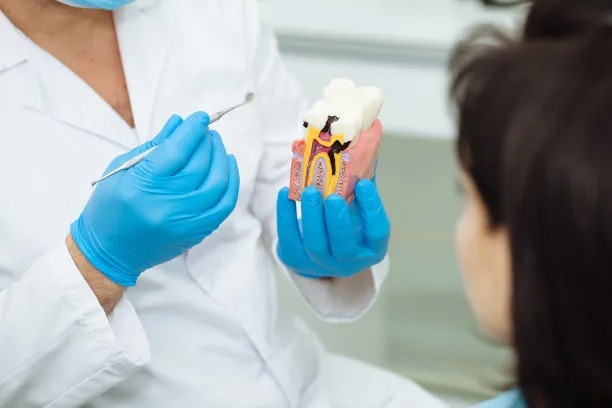Essential Steps to Ensure Safe and Effective Root Canal Treatment for Optimal Dental Health
Summary: Root canal treatment is essential for maintaining optimal dental health, especially when dealing with infection or decay affecting the pulp. This article outlines four critical aspects to ensure safe and effective root canal procedures: the importance of proper diagnosis, the selection of effective treatment techniques, post-treatment care, and the role of patient communication. By adhering to these essential steps, dental professionals and patients can work together to achieve the best possible outcomes for root canal therapy, minimizing discomfort and maximizing the longevity of dental health.
1. Importance of Proper Diagnosis in Treatment

The foundation of effective root canal treatment begins with a proper diagnosis. Dentists utilize various diagnostic tools, including X-rays and clinical examinations, to assess the condition of the tooth and surrounding tissues. Identifying the specific type of pulp disease—whether its irreversible pulpitis, necrosis, or apical periodontitis—is essential to determine the appropriate treatment plan.
Once the correct diagnosis is established, the dental professional can explain the nature of the problem to the patient, including the need for a root canal. Clear communication ensures that patients understand the reasons for the procedure and are more likely to cooperate throughout the treatment process. Such transparency builds trust and alleviates anxiety related to the procedure.
Additionally, timely diagnosis is critical in preventing the spread of infection to adjacent teeth or tissues. Delays in diagnosis can lead to complications that complicate treatment, making it more essential for dental practitioners to remain vigilant in recognizing signs of dental distress early.
2. Selection of Effective Treatment Techniques
Once the diagnosis is made, selecting the appropriate technique for root canal treatment is crucial. Various methods exist, including traditional hand instrumentation and modern rotary systems that increase efficiency and precision. Modern techniques can reduce treatment time and often result in improved outcomes by minimizing the risk of canal blockage or instrument breakage.
Moreover, utilizing advanced technologies such as digital imaging and apex locators can enhance the accuracy of root canal treatment. These tools allow dentists to visualize the root canal system more effectively and measure the length of the canals accurately, aiding in thorough cleaning and shaping during the procedure.
Considering the specific anatomy of the tooth is also vital in deciding the treatment method. Each tooth may have a unique root canal structure, and customizing the approach increases the likelihood of successful treatment. Dentists must be knowledgeable about these anatomical variations to achieve optimal results.
3. Post-Treatment Care for Long-Term Health
After the completion of a root canal procedure, proper post-treatment care is essential to ensure a successful recovery and maintain optimal dental health. Dentists typically provide patients with clear instructions regarding pain management and the importance of avoiding hard foods for a few days following the treatment. Adhering to these guidelines can significantly reduce discomfort and expedite healing.
Another critical aspect of post-treatment care involves regular follow-up appointments. These visits allow the dentist to monitor healing and address any complications that may arise. Consistent check-ups serve as a preventive measure against potential reinfection and assist in maintaining the integrity of the treated tooth.
Furthermore, patient education on maintaining proper oral hygiene is vital. Patients should be encouraged to brush and floss regularly and use antiseptic mouthwash to prevent bacteria buildup in the mouth. Adopting a diligent oral care routine contributes enormously to long-term success following root canal treatment.
4. The Role of Patient Communication
Effective communication between dental professionals and patients plays a significant role in the success of root canal therapy. Creating an environment where patients feel comfortable expressing their concerns about treatment can significantly influence their overall experience. Dentists should encourage questions and provide comprehensive answers, ensuring patients feel informed and empowered during their dental journey.
Additionally, leveraging digital platforms for communication can enhance the patient experience. Sending reminders for appointments, follow-ups, and educational materials through emails or text messages keeps patients engaged and well-informed about their dental health. This proactive communication strategy fosters a sense of responsibility among patients regarding their oral care.
Ultimately, establishing a strong patient-dentist relationship built on trust and transparency significantly impacts treatment outcomes. When patients feel supported and well-informed, they are more likely to adhere to treatment recommendations and attend follow-up appointments, leading to better long-term dental health.
Summary:
Root canal treatment is a critical component of dental care that requires careful consideration of diagnostic accuracy, technique selection, diligent post-treatment measures, and clear patient communication. By following these essential steps, dentists can provide safe and effective care that promotes optimal dental health. Strengthening these elements not only enhances patient outcomes but also ensures they feel supported throughout their treatment journey.
This article is compiled by Vickong Dental and the content is for reference only.



